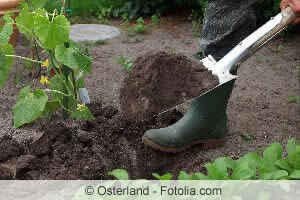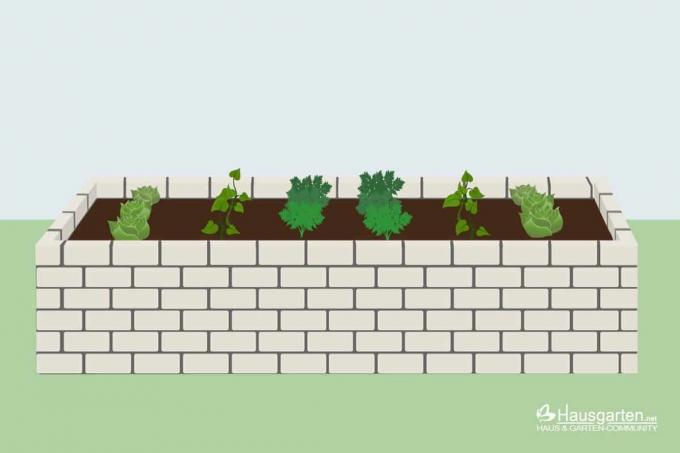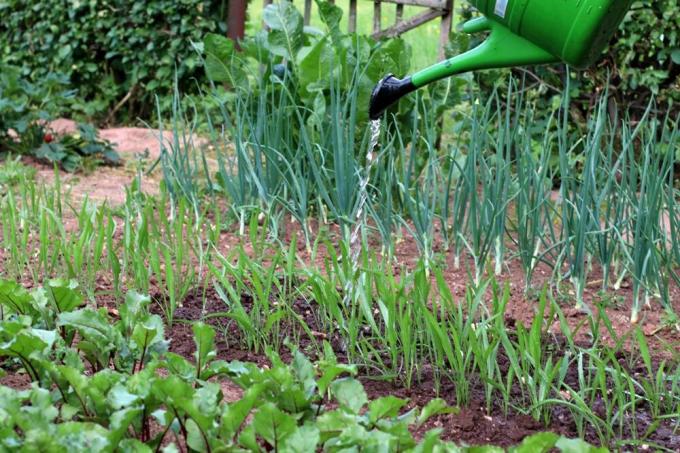
Table of contents
- Good planning is a prerequisite
- Location
- Create the best conditions
- Floor
- Which vegetables to grow when?
- cold frame and raised bed
- Mixed culture – what goes together?
- crop rotation
- Which vegetables may not be grown one after the other?
- Four-field economy or four-year crop rotation
- Which vegetables are heavy consumers?
- Medium-consuming vegetables
- Weakly consuming vegetables
- Examples of two beds with alternating planting
- Conclusion
If you want to plant a vegetable patch in your garden, you have to work out a good concept in advance so that your project will be successful for years to come. Different types of vegetables require different amounts of nutrients. In addition, deficiency symptoms or diseases often occur in monocultures or constantly the same planting. Therefore, it is important to know in which combination and order the different vegetables should be grown in the vegetable patch.
Good planning is a prerequisite
If you intend to plant a vegetable patch in your garden, you should start planning in the autumn or winter of the previous year. The future cultivation areas can already be prepared now. Choose an area in the garden that is easily accessible and meets the necessary site conditions. In addition, the bed can already be dug up in autumn, the soil can be improved and possibly manure or compost can be worked in to provide nutrients. Newcomers should start small and gradually familiarize themselves with the vegetable concept. Work that can be done in advance:
- fertilization
- soil improvement
- Planning of the planting sequence and mixed culture
- get seeds
- in February, the pre-cultivation of the plants on the windowsill begins
Tip:
A vegetable patch should not be more than 1.30 meters wide, as this guarantees that the area can be easily reached from all sides. If in doubt, it is better to plant several small beds than one large one.
Location
Almost all types of vegetables prefer a sunny to partially shaded location in the garden. Some species also tolerate the midday sun well. Overall, however, a bed that provides shade for a few hours a day would be ideal.
- sunny to semi-shady
- at least five to six hours of sun per day
- a windbreak may be necessary in drafty places
Create the best conditions
Two things are particularly important for the vegetables to grow really well:
- a good ground
- high quality seed
- alternatively early plants from the nursery

Floor
Well-drained, humus-rich garden soil is particularly suitable for a vegetable bed. If the soil is not optimal, it must be prepared accordingly before cultivation. If you are not sure of the quality of your garden soil, you can order a soil analysis for just a few euros (sets are available in garden centers or pharmacies).
- Fertilize the soil with compost in the fall
- possibly incorporate sand
- Dig up again in the spring and loosen the soil
- Remove stones, roots and weeds
Which vegetables to grow when?
Once the cultivation area has been determined and possibly already prepared, the actual, creative gardening begins. The choice of vegetable plants is made according to one's own taste, so a gardener should consider which types of vegetables he wants to grow at all. The plants are then divided into two groups:
- Long-growing vegetables (main crop): such as potatoes, cabbage, cucumbers and carrots
- Vegetables with a short growing period (pre- and post-culture): such as spinach or French beans
So that the bed can be used as best as possible, each main culture is now combined with a pre- and/or post-culture to form a specific crop rotation. It is important to ensure that not only do the cultivation times match, but that the plants also "get along" with each other. Not all types of vegetables can be grown one after the other or together in the bed.
Tip:
In order not to miss the time of sowing, planting and harvesting, the dates should be noted in the calendar early on.
cold frame and raised bed
Covered beds or a raised bed have proven to be ideal for cultivating cold-sensitive lettuce and vegetable plants. The temperatures here are already higher in early spring, when the rest of the ground in the garden may still be frozen, which prevents frost damage. Ideal to give the plants a head start on the outdoor plants and to be able to harvest early.
Mixed culture – what goes together?
In addition to the right site conditions and soil properties, the compatibility of the individual types of vegetables with each other must also be taken into account when planting a vegetable bed. A distinction is made here:
- neutral plants: Can be easily combined with other plants
- promoting plants: certain combinations influence each other positively
- inhibitory plants: combinations that hinder each other's growth
If you want to create a vegetable patch properly, you should check in advance what goes together and what doesn't. Here are some combinations that get along well and encourage each other:
- Carrots with Swiss chard, garlic, peas, radishes, tomatoes, salsify, onions
- Potatoes with French beans, kohlrabi, horseradish, caraway
- Cauliflower with celery, peas and French beans
- Zucchini with onions, runner beans and basil
- Cucumbers with fennel, cabbage, beetroot, lettuce, peas
crop rotation
Another crucial role in vegetable cultivation is crop rotation. Crop rotation refers to the order in which the vegetable plants are grown one after the other in the same bed. Not only can the nutrients in the soil be optimally utilized, but diseases can also be avoided. If a vegetable patch is set up correctly, it contains high levels of nutrients in the first spring. Therefore, it makes sense to first grow those types of vegetables that are very consuming, i.e. that remove large amounts of nutrients from the soil. The three-year crop rotation has proven itself:
- First year: Grow mostly heavy-feeding vegetables
- Second year: plant moderately heavy-duty vegetables
- Third year: Cultivate moderately to lightly demanding vegetables
In the autumn of the third year, the bed is completely harvested and fertilized with compost again. The compost can then rot well over the winter. This means that the vegetable patch is once again optimally prepared for planting in the spring. Now we start again with the heavy feeders.
Which vegetables may not be grown one after the other?
Plants that belong to the same plant family may not be planted in the same bed in the following year. Two plant families are particularly affected here:
- Goosefoot family (Chenopodiaceae): Swiss chard, beetroot, spinach
- Cruciferous vegetables (Brassiacaceae): Radishes and radishes, all types of cabbage, turnips (such as turnips)
If this rule is not observed, it can lead to a stubborn infestation with pests such as clubroot.
Four-field economy or four-year crop rotation
If you have a little more space in the garden, you should divide your bed into four areas or create four different beds. In the case of four-field farming, the crop rotation model is applied to each of the four plots, each time shifted by one year. While a bed has a high nutrient content and is planted with heavy-duty plants, there are also a bed with medium-consuming plants and one cultivated with low-consuming vegetables becomes. The fourth bed is fallow for a year or is subjected to green manure to regenerate.
- Bed 1 green manure: Growth conditions for future crops are optimized. In addition, green manure suppresses weeds and protects against soil erosion.
- Bed 2: first year of the three-year crop rotation (heavy feeders)
- Bed 3: second year of the three-year crop rotation (medium eaters)
- Bed 4: third year of the three-year crop rotation (weak feeders)
The change to weaker consuming plants takes place on an annual basis. After the nutrients are consumed, a green manure is planted in the fourth year.
Which vegetables are heavy consumers?
The following varieties require particularly high levels of nutrients in the soil. Therefore, they are planted on the vegetable patch in the year after green manure or after fertilization with compost, for example:
- cabbage
- potatoes
- carrots
Medium-consuming vegetables
In the second year, vegetables that require medium nutrient levels are in demand. These include:
- Peas
- beans
- cucumbers
- fennel
- leek
- radish
- tomatoes
- paprika
- Kohlrabi
- onions
Weakly consuming vegetables
In the third year, only low levels of nutrients are left in the soil. In order to be able to use these optimally, the following plants are recommended:
- salad
- Herbs
- cress
Tip:
Tomatoes, rhubarb, strawberries and asparagus can be grown in the same location for many years.
Examples of two beds with alternating planting
bed 1
- 1. Year: cauliflower and broccoli
- 2. Year: Strawberries
- 3. Year: Strawberries
bed 2
- 1. Year: kohlrabi and savoy cabbage
- 2. Year: Chinese cabbage and endive
- 3. Year: annual herbs
bed 3
- 1. Year: Potatoes
- 2. Year: celery and tomatoes
- 3. Year: lettuce and peas
Conclusion
Creating a vegetable patch properly is sometimes not that easy for beginners. The best thing to do is to start small and only cultivate a small area, which you plant over three years with different vegetable plants according to crop rotation and mixed cultivation. It is best to create a precise three-year plan right from the start, which should be meticulously adhered to during this time. More experienced gardeners can then include an additional pre- or post-culture in the second year.
 garden editorial
garden editorial I write about everything that interests me in my garden.
Learn more about creating a vegetable garden

Build your own raised bed out of stones: this is how it works
Building a raised bed out of stones is more complex than variants made out of wood or aerated concrete. On the other hand, they are very durable, decorative, offer decisive advantages and can even increase yields. We explain how it works here.

18 good neighbors of broccoli | mixed culture
Broccoli is a close relative of cauliflower and a great homegrown vegetable. In the vegetable garden, it is generally advisable to pay attention to good plant neighbors. A corresponding mixed culture has many advantages for all species involved.

Paths in the vegetable garden: 7 ideas for beautiful and practical bed paths
As a rule, there is no way in the vegetable garden without paths. Only through them can all beds be easily reached. Of course you have to think about how to create and design them. Here are some tips and ideas.

Creating a vegetable garden for beginners – instructions incl. plan
Quite a few people today dream of harvesting their own vegetables and being self-sufficient. No wonder: you know where it comes from and what's in it. You are also a bit more independent. Of course you need a garden for that. What is important when creating a vegetable garden is here.

Planning a vegetable garden - my first small self-sufficient garden
The vegetable garden is an important first step on the way to independent self-sufficiency. In order for your self-sufficient life to get off to a good start, it depends on the right planning, from A, for cultivation area, to Z, for fence. This step-by-step guide explains how to make your first small self-sufficient garden perfect.

Choose the right film for the raised bed
Raised beds are not only a big trend, they can make growing fresh vegetables and aromatic herbs a lot easier. With a flexible choice of location, the design options are almost inexhaustible. Raised beds can be made of different materials that suffer to varying degrees from soil moisture. This requires good protection.



